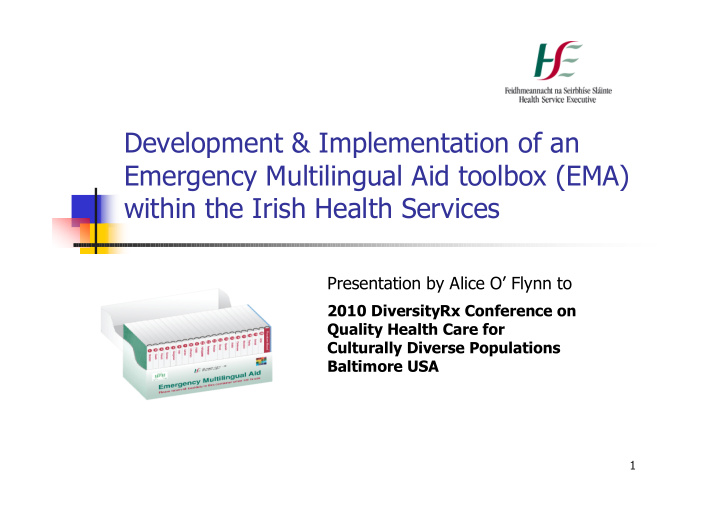



Development & Implementation of an Emergency Multilingual Aid toolbox (EMA) within the Irish Health Services Presentation by Alice O’ Flynn to 2010 DiversityRx Conference on Quality Health Care for Culturally Diverse Populations Baltimore USA 1
What is the EMA? • Resource designed to assist healthcare staff in communicating speedily & more effectively with patients with limited English proficiency who present in acute or emergency situations • Developed in consultation with frontline staff & service users • Allows staff to screen & form a preliminary assessment of patient • Takes into account and learns from health professionals in other countries Not intended to replace services of a Professional Interpreter Available as hard copy and as CD Can be downloaded from www.hse.ie (Look in Publications section) 2
What’s in the box? • Welcome Sheet • Language Identification Card • Twenty multilingual phrasebooks containing : 160 questions in those languages presently identified as most widely spoken in Ireland viz Irish, French, Polish, Czech, German, Bosnian, Hungarian, Latvian, Lithuanian, Portuguese, Romanian, Russian, Slovak, Spanish, Arabic, Cantonese, Mandarin, Pashtu, Somali and Urdu . Each phrasebook is divided into sections, containing questions related to Admission , Assessment, Clinical Care, Maternity, Discharge , with an additional chapter containing common questions patients may have around their needs or discomfort • “On Speaking Terms”: A User Manual containing guidelines for staff on accessing and using interpreters • A CD containing digital versions of the EMA 3
Why an EMA? Changing Landscape • Pressures on resources • Shifting priorities • Migration to Ireland - ^ diversity of population • Recession • Statutory obligations • Social changes • Changes in attitudes • Drive to improve and clarify referral and clinical pathways • Clinical risk/ safety 4
How did we do it? • A Partnership approach was fundamental – including working with NGO’s who provide advocacy and advise services to ethnic minority communities, migrants etc •Staff on front line identified key questions within triage in ED’s •Staff in number of hospitals piloted first EMA (A4 paper version) •Pilot completed, feedback, evaluation and subsequently refined •Process agreed to refine questions, which languages, process for translation, final layout & production…. aim to produce user friendly accessible resource •Hospital settings where EMA would be most valuable? E.g. ED’s, Out Patients, Maternity, Paediatrics.. • Recognition that ongoing support for staff required to facilitate rollout and encourage usage of EMA • Support and training networks put in place to ensure optimal rollout and usage • Detailed Work plan with timeline, accountabilities etc; regularly updated 5
Rollout of EMA • 350 EMA’s distributed to 52 hospitals across Ireland • Distributed also to NGO agencies • 4 Regional Coordinators assigned within hospitals in North, South, East & West • Liaison person nominated in each hospital; regular contact maintained in preparation for rollout • Training offered and coordinated via 4 co ordinators; online methods used also • Delivery organised on regional/ local basis; to nominated person; • CDs posted where appropriate • Email address on Welcome Sheet for comments, feedback, queries … 6
Ongoing Work •Interest in EMA also from medical and nursing educational institutions •Also interest from other health professionals e.g. General Practitioners, Mental health, etc •Evaluation process in place to learn about usage, usefulness etc… • Pre and post questionnaires in place • Ongoing support to users of EMA has been crucial 7
What have we learned so far? • Not nearly as easy and straightforward as it seemed! • Translation of core questions – Source text should be absolutely complete and accurate prior to passing this to translators • Validation of accuracy of text – what is best practice? • Managing elements of culture proofing – how can this be best achieved cost effectively? • Training of staff essential in ensuring usage of resources – need to devise creative ways of providing training and offering ongoing support • Attention to detail in planning around smooth preparation and rollout Mark Twain (1835-1910): “Be careful about reading health books. You may die of a misprint.” 8
What have we learned thus far? (cont.) Limitations of EMA • Assumes patient is literate in own language • Not appropriate if patient cannot read the questions • Range of questions is necessarily limited • Limited opportunity for patient to raise concerns 9
New Developments and Next Steps • Potential for application in other healthcare settings •Currently being trialled in a number of GP practices, Local Health Centres, Direct Provision Centres (asylum seekers), Mental health settings, National Cancer Screening service • Collaboration with Ambulance service towards adapting resource 10
Also of Interest……. Health Services Intercultural Guide •Profiles the religious and cultural needs of 25 diverse groups that are cared for in healthcare settings. •Produced in consultation with cultural /faith leaders and informants and following extensive research Key practice points around caring for the ill, particularly in inpatient settings, and care of the dying - adults and children… •Distributed to hospitals, hospices, residential services and educational institutions 11
Finally………. …The Irish Health Services Executive following consultation with patients, services users and staff developed a National Intercultural Health Strategy in 2008 which provides a framework of initiatives to build capacity to deliver culturally competent health care This presentation on the Emergency Multilingual Aid resource is one of the ways we are implementing the NIHS as is the Intercultural Health Guide All of the materials described in this presentation can be downloaded from •www.hse.ie For further information or if you have any queries/comments etc..get in touch with us at alice.oflynn@hse.ie George Bernard Shaw (1856-1950): “The single biggest problem in communication is the illusion that it has taken place!” 12
Recommend
More recommend